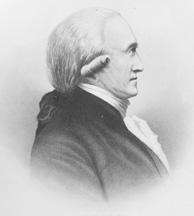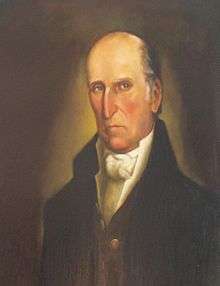Treaty of Hopewell
The Treaty of Hopewell was signed by the Choctaw at the foothills of the Smoky Mountains on January 3, 1786. The ceded mounted to 69,120 acres, and the compensation to the Choctaw took the form of protection by the United States.[1] To elaborate, the plenipoteniaries were Benjamin Hawkins, Andrew Pickens and Joseph Martin representing the U.S. while representing the Choctaw were 13 small medal and 12 medal and gorget captains.
1785

On November 28, 1785, the first Treaty of Hopewell was signed between the U.S. representative Benjamin Hawkins and the Cherokee Indians. The treaty laid out a western boundary for American settlement. The treaty gave rise to the sardonic Cherokee phrase of Talking Leaves, since they claimed that when the treaties no longer suited the Americans, they would blow away like talking leaves. A description of the boundary is found on Article 4 of the accord:
The boundary allotted to the Cherokees for their hunting grounds, between the said Indians and the citizens of the United States, within the limits of the United States of America, is, and shall be the following, viz. Beginning at the mouth of Duck river, on the Tennessee; thence running north-east to the ridge dividing the waters running into Cumberland from those running into the Tennessee; thence east-wardly along the said ridge to a north-east line to be run, which shall strike the river Cumberland forty miles above Nashville; thence along the said line to the river; thence up the said river to the ford where the Kentucky road crosses the river; thence to Campbell's line, near Cumberland gap; thence to the mouth of Claud's creek on Holstein; thence to the Chimney-top mountain; thence to Camp-creek, near the mouth of Big Limestone, on Nolichuckey; thence a southerly course six miles to a mountain; thence south to the North-Carolina line; thence to the South-Carolina Indian boundary, and along the same south-west over the top of the Oconee mountain till it shall strike Tugaloo river; thence a direct line to the top of the Currohee mountain; thence to the head of the south fork of Oconee river.[2]
Included in the signatures of the Cherokee delegation were several from leaders of the Chickamauga (Lower Cherokee), including two from the town of Chickamauga itself and one from Lookout Mountain Town.
The Cherokee complained at the treaty that some 3,000 white settlers of the de facto State of Franklin were already squatting on the Cherokee side of the agreed line, between the Holston and French Broad Rivers, and they continued to dispute that region until a new border was defined by the 1791 Treaty of Holston.[3]
1785–1786

Cherokee
On November 28, 1785, the first Treaty of Hopewell was signed between U.S. representatives Benjamin Hawkins, Andrew Pickens, and Joseph Martin and members of the Cherokee People.
Cherokee treaty terms
The preamble begins with,
THE Commissioners Plenipotentiary of the United States of America give peace to all the Cherokee nation, and receive them into the favor and protection of the United States of America, on the following conditions: ...
— Treaty of Hopewell, 1785
The following lists the terms of the treaty:
1. Indians to restore prisoners (who are U.S. citizens or their allies), slaves, and property.
2. The United States to restore prisoners to the Indians.
3. Cherokees acknowledge protection provided by the United States.
4. Boundaries defined.
5. No citizen of United States shall settle on Indian lands and Indians may punish violators as they please.
6. Indians to deliver criminals who commit robbery, murder, or capital crimes.
7. Citizens of United States committing crimes against Indians to be punished.
8. Retaliation restrained.
9. United States to regulate trade.
10. Special provision for trade.
11. Cherokees to give notice of any known designs against United States by tribes or any person.
12. Indians may send a "deputy," i.e., representative, to Congress.
13. Peace and friendship perpetual.
Choctaw
On January 3, 1786, the Treaty of Hopewell was signed between U.S. representatives Benjamin Hawkins, Andrew Pickens, and Joseph Martin and members of the Choctaw People.
Choctaw treaty terms
The preamble begins with,
THE Commissioners Plenipotentiary of the United States of America give peace to all the Choctaw nation, and receive them into the favor and protection of the United States of America, on the following conditions: ...
— Treaty of Hopewell, 1786
The following lists the terms of the treaty:
1. Indians to restore prisoners (who are U.S. citizens or their allies), slaves, and property.
2. Choctaws acknowledge protection provided by the United States.
3. Boundaries defined.
4. No citizen of United States shall settle on Indian lands and Indians may punish violators as they please.
5. Indians to deliver criminals who commit robbery, murder, or capital crimes.
6. Citizens of United States committing crimes against Indians to be punished.
7. Retaliation restrained.
8. United States to regulate trade.
9. Special provision for trade.
10. Choctaws to give notice of any known designs against United States by tribes or any person.
11. Peace and friendship perpetual.
Chickasaw
On January 10, 1786, the Treaty of Hopewell was signed between U.S. representatives Benjamin Hawkins, Andrew Pickens, and Joseph Martin and the Chickasaw leaders Taski Etoka, Piomingo, and Lotapaia.[4]
Chickasaw treaty terms
The preamble begins with,
THE Commissioners Plenipotentiary of the United States of America give peace to the Chickasaw People, and receive them into the favor and protection of the said States, on the following conditions: ...
— Final Treaty of Hopewell, 1786
The following lists the terms of the treaty:
1. Indians to restore prisoners, slaves, and property.
2. Acknowledge the protection of United States.
3. Boundaries defined.
4. No citizen of United States shall settle on Indian lands and Chickasaws may punish them as they please.
5. Indians to deliver up criminals.
6. Citizens of United States committing crimes against Indians to be punished.
7. Retaliation restrained.
8. United States to regulate trade.
9. Special provision for trade
10. Indians to give notice of any known designs against United States.
11. Peace and friendship perpetual.
See also
- List of Choctaw Treaties
- List of treaties
References
- Reeves, Carolyn K. The Choctaw before Removal. University Press of Mississippi Jackson. 214.
- Indian Affairs: Laws and Treaties (Text of the 1785 Cherokee Treaty).
- Mooney, Myths of the Cherokee, p. 61 ff.
- "The Last of the Chickasaw Kings" archived
External links
- "Indian Affairs: Laws and Treaties. Vol. 2, Treaties (Treaty with the Cherokee Treaty, 1785)". 2020-05-12. Archived from the original on 2012-07-10.
- Indian Affairs: Laws and Treaties (Text of the 1786 Choctaw Treaty)
- "Indian Affairs: Laws and Treaties. Vol. 2, Treaties (Text of the 1785 Cherokee Treaty)". 2012-07-10. Archived from the original on 2012-07-10.
- Indian Affairs: Laws and Treaties (Text of the 1786 Choctaw Treaty)
- "Indian Affairs: Laws and Treaties. Vol. 2, Treaties (Text of the 1786 Chickasaw Treaty)". 2012-12-12. Archived from the original on 2012-12-12.
- Treaty of Hopewell Profile and Videos - Chickasaw.TV